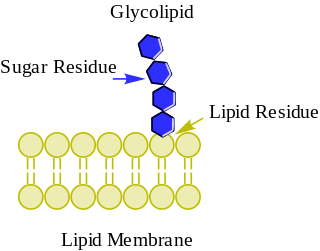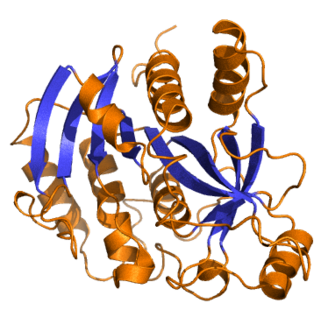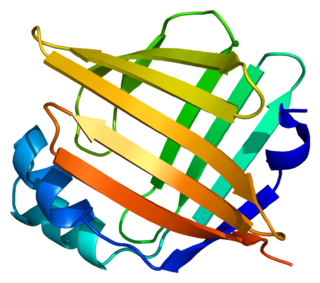
Metabolism is the set of life-sustaining chemical reactions in organisms. The three main purposes of metabolism are: the conversion of the energy in food to energy available to run cellular processes; the conversion of food to building blocks for proteins, lipids, nucleic acids, and some carbohydrates; and the elimination of metabolic wastes. These enzyme-catalyzed reactions allow organisms to grow and reproduce, maintain their structures, and respond to their environments. The word metabolism can also refer to the sum of all chemical reactions that occur in living organisms, including digestion and the transportation of substances into and between different cells, in which case the above described set of reactions within the cells is called intermediary metabolism.

A phospholipase is an enzyme that hydrolyzes phospholipids into fatty acids and other lipophilic substances. Acids trigger the release of bound calcium from cellular stores and the consequent increase in free cytosolic Ca2+, an essential step in calcium signaling to regulate intracellular processes. There are four major classes, termed A, B, C, and D, which are distinguished by the type of reaction which they catalyze:

In chemistry, phosphorylation of a molecule is the attachment of a phosphoryl group. This process and its inverse, dephosphorylation, are critical for many cellular processes in biology. Protein phosphorylation is especially important for their function; for example, this modification activates almost half of the enzymes present in Saccharomyces cerevisiae, thereby regulating their function. Many proteins are phosphorylated temporarily, as are many sugars, lipids, and other biologically-relevant molecules.

Frederick Sanger was an English biochemist who twice won the Nobel Prize in Chemistry. He is one of only two people to have done so in the same category, and the fourth person with two Nobel Prizes. In 1958, he was awarded a Nobel Prize in Chemistry "for his work on the structure of proteins, especially that of insulin". In 1980, Walter Gilbert and Sanger shared half of the chemistry prize "for their contributions concerning the determination of base sequences in nucleic acids". The other half was awarded to Paul Berg "for his fundamental studies of the biochemistry of nucleic acids, with particular regard to recombinant DNA".

A sulfonate is a salt or ester of a sulfonic acid. It contains the functional group R-SO−
3, where R is an organic group. Sulfonates are the conjugate base of sulfonic acids. Sulfonates are generally stable in water, non-oxidizing, and colorless. Many useful compounds and even some biochemicals feature sulfonates.

Galactokinase is an enzyme (phosphotransferase) that facilitates the phosphorylation of α-D-galactose to galactose 1-phosphate at the expense of one molecule of ATP. Galactokinase catalyzes the second step of the Leloir pathway, a metabolic pathway found in most organisms for the catabolism of α-D-galactose to glucose 1-phosphate. First isolated from mammalian liver, galactokinase has been studied extensively in yeast, archaea, plants, and humans.

Glycolipids are lipids with a carbohydrate attached by a glycosidic (covalent) bond. Their role is to maintain the stability of the cell membrane and to facilitate cellular recognition, which is crucial to the immune response and in the connections that allow cells to connect to one another to form tissues. Glycolipids are found on the surface of all eukaryotic cell membranes, where they extend from the phospholipid bilayer into the extracellular environment.
Sulfoquinovosyl diacylglycerols, abbreviated SQDG, are a class of sulfur-containing but phosphorus-free lipids (sulfolipids) found in many photosynthetic organisms.

FGF1, also known as acidic fibroblast growth factor (aFGF), is a growth factor and signaling protein encoded by the FGF1 gene. It is synthesized as a 155 amino acid polypeptide, whose mature form is a non-glycosylated 17-18 kDa protein. Fibroblast growth factor protein was first purified in 1975, but soon afterwards others using different conditions isolated acidic FGF, Heparin-binding growth factor-1, and Endothelial cell growth factor-1. Gene sequencing revealed that this group was actually the same growth factor and that FGF1 was a member of a family of FGF proteins.

Purine nucleoside phosphorylase, PNP, PNPase or inosine phosphorylase is an enzyme that in humans is encoded by the NP gene. It catalyzes the chemical reaction
UDP-sulfoquinovose synthase (EC 3.13.1.1) is an enzyme that catalyzes the chemical reaction
Richard Tecwyn Williams FRS was a Welsh biochemist who founded the systematic study of xenobiotic metabolism with the publication of his book Detoxication mechanisms in 1947. This seminal book built on his earlier work on the role of glucuronic acid in the metabolism of borneol.

Fatty acid-binding protein, epidermal is a protein that in humans is encoded by the FABP5 gene.

Sialin, also known as H(+)/nitrate cotransporter and H(+)/sialic acid cotransporter, is a protein which in humans is encoded by the SLC17A5 gene.
Sulfolipids are a class of lipids which possess a sulfur-containing functional group. An abundant sulfolipid is sulfoquinovosyl diacylglycerol, which is composed of a glycoside of sulfoquinovose and diacylglycerol. In plants, sulfoquinovosyl diacylglycerides (SQDG) are important members of the sulfur cycle. Other important sulfolipids include sulfatide and seminolipid, each of which are sulfated glycolipids. Sulfolipids have been implicated in the functions of two of the core components of the photosynthetic electron transport chain and while not necessarily essential, might have a protective function when the photosynthetic apparatus is under stress.
The Colworth Medal is awarded annually by the Biochemical Society to an outstanding research biochemist under the age of 35 and working mainly in the United Kingdom. The award is one of the most prestigious recognitions for young scientists in the UK, and was established by Tony James FRS at Unilever Research and Henry Arnstein of the Biochemical Society and takes its name from a Unilever research laboratory near Bedford in the UK, Colworth House.

Mannoheptulose is a heptose, a monosaccharide with seven carbon atoms, and a ketose, with the characteristic carbonyl group of the carbohydrate present on a secondary carbon. The sugar alcohol form of mannoheptulose is known as perseitol.
Maximilian Nierenstein was a professor of biochemistry at the University of Bristol.

In biochemistry, non-coded or non-proteinogenic amino acids are distinct from the 22 proteinogenic amino acids which are naturally encoded in the genome of organisms for the assembly of proteins. However, over 140 non-proteinogenic amino acids occur naturally in proteins and thousands more may occur in nature or be synthesized in the laboratory. Many non-proteinogenic amino acids are important:
Sulfoglycolysis is a catabolic process in primary metabolism in which sulfoquinovose (6-deoxy-6-sulfonato-glucose) is metabolized to produce energy and carbon-building blocks. Sulfoglycolysis pathways occur in a wide variety of organisms, and enable key steps in the degradation of sulfoquinovosyl diacylglycerol (SQDG), a sulfolipid found in plants and cyanobacteria into sulfite and sulfate. Sulfoglycolysis converts sulfoquinovose (C6H12O8S−) into various smaller metabolizable carbon fragments such as pyruvate and dihydroxyacetone phosphate that enter central metabolism. The free energy is used to form the high-energy molecules ATP (adenosine triphosphate) and NADH (reduced nicotinamide adenine dinucleotide). Unlike glycolysis, which allows metabolism of all carbons in glucose, some sulfoglycolysis pathways convert only a fraction of the carbon content of sulfoquinovose into smaller metabolizable fragments; the remaineder is excreted as C3-sulfonates 2,3-dihydroxypropanesulfonate (DHPS) or sulfolactate (SL); or the C2-sulfonate isethionate.













